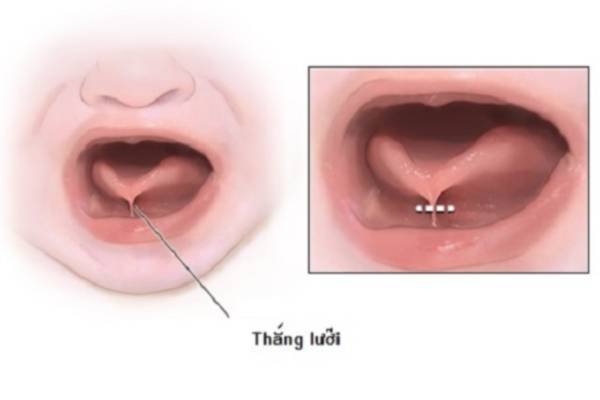Treatment of tongue-tie in young children
The article was consulted with Dr. Nguyen Hung Tien - Department of Pediatrics - Neonatology, Vinmec Hai Phong International General Hospital.
Adhesions of the tongue brake are one of the birth defects that children can have due to the shortening of the tongue brake and restricting the normal movements of the tip of the tongue. According to statistics, about 5% of babies are born with this defect, with a higher rate in boys than girls.
1. How to recognize tongue tie in children
Any infant or child is at risk of developing tongue tie, depending on the severity and age of the child, there are specific outward manifestations. Parents can recognize the tongue tie in children through such expressions as:
Abnormally short tongue tie; The tongue brake wire is stuck right next to the tip of the tongue or the tip of the tongue; The child cannot bring his tongue to the upper front teeth; The tip of the tongue cannot be moved beyond the mandibular incisors by more than 1 - 2 mm; Having difficulty moving the tongue sideways; When the baby sticks out his tongue, he sees a heart shape.
Abnormally short tongue tie; The tongue brake wire is stuck right next to the tip of the tongue or the tip of the tongue; The child cannot bring his tongue to the upper front teeth; The tip of the tongue cannot be moved beyond the mandibular incisors by more than 1 - 2 mm; Having difficulty moving the tongue sideways; When the baby sticks out his tongue, he sees a heart shape.
2. Confirmed diagnosis of adhesion of the tongue brake
Determining the diagnosis of laryngeal adhesions is very important in making a treatment plan for the child. Diagnosis can be made by measuring the length of the tongue cord from the floor of the mouth to the underside of the tongue, if it is less than 16mm, it means that the child has a tongue tie.
Tongue adhesions in young children have the following degrees:
Grade 1: Mild adhesions with a length of 12-16 mm; Grade 2: Lightly adherent with a length of 8 -11 mm; Grade 3: Lightly adhered with a length of 3-7 mm; Grade 4: Lightly adhered to less than 3 mm in length. Children with laryngotracheal cord adhesions in degrees 1 and 2 need further monitoring. In case of laryngotracheal adhesions in degrees 3 and 4, surgery is required. However, in order to determine whether or not surgery is needed to stick the tongue brake in children, it is necessary to visit a dental specialist to be examined and properly diagnosed.
Tongue adhesions in young children have the following degrees:
Grade 1: Mild adhesions with a length of 12-16 mm; Grade 2: Lightly adherent with a length of 8 -11 mm; Grade 3: Lightly adhered with a length of 3-7 mm; Grade 4: Lightly adhered to less than 3 mm in length. Children with laryngotracheal cord adhesions in degrees 1 and 2 need further monitoring. In case of laryngotracheal adhesions in degrees 3 and 4, surgery is required. However, in order to determine whether or not surgery is needed to stick the tongue brake in children, it is necessary to visit a dental specialist to be examined and properly diagnosed.

Cha mẹ có thể nhận biết tật dính thắng lưỡi ở trẻ thông qua những biểu hiện như dây thắng lưỡi ngắn bất thường
3. How does tongue tie affect children?
The tongue tie not only affects the child's pronunciation, but also makes it difficult for the child to speak, making the voice lisp. In addition, sticking to the tongue brake also causes many other effects such as:
Difficulty in eating because when swallowing the tongue is shrunk in a difficult way, so the child is anorexic, slow to grow; Aesthetic loss of teeth because of tongue-tie can cause the lower front teeth to tilt or have a gap.
Difficulty in eating because when swallowing the tongue is shrunk in a difficult way, so the child is anorexic, slow to grow; Aesthetic loss of teeth because of tongue-tie can cause the lower front teeth to tilt or have a gap.
4. Is surgery to cut tongue adhesions in children dangerous?

Phẫu thuật dính thắng lưỡi ở trẻ thực hiện khá đơn giản, không hề gây nguy hiểm
The tongue brake or tongue brake is a thin triangular-shaped mucosal membrane that is attached from the floor of the mouth to the underside of the tongue. Children with tongue tie will have limited tongue movement than normal, if not handled properly, it will make it difficult for the baby to suckle, slow to gain weight, hurt the mother's nipples, large potentially difficult to pronounce some syllables.
Most parents, when they know that their child has a tongue tie, are worried and don't know if the surgery is dangerous or not. In fact, surgery to stick the tongue in children is quite simple and not dangerous, but parents need to choose a reputable medical facility with a system of facilities, machines and equipment. ensure that the surgery goes smoothly and safely.
Newborns with 3rd and 4th degree of laryngeal adhesions can be operated on at 3 months of age.
Depending on the age, the method will be performed differently, however, most only need local anesthesia (done at the clinic) and if general anesthesia is required, hospitalization is required. Children who have the tongue tie cut with anesthesia can go home the same day and use ordinary pain relievers, can drink cold milk or breastfeed after 30 minutes of cutting.
When seeing a child showing signs of tongue-tie, parents can take the child to Vinmec International General Hospital for examination, diagnosis and treatment. Here, there is a team of specialized doctors of Odonto-Stomatology, who are well-trained, experienced and professional; system of modern equipment, meeting international standards; Professional service quality, high efficiency in diagnosis and treatment.
Most parents, when they know that their child has a tongue tie, are worried and don't know if the surgery is dangerous or not. In fact, surgery to stick the tongue in children is quite simple and not dangerous, but parents need to choose a reputable medical facility with a system of facilities, machines and equipment. ensure that the surgery goes smoothly and safely.
Newborns with 3rd and 4th degree of laryngeal adhesions can be operated on at 3 months of age.
Depending on the age, the method will be performed differently, however, most only need local anesthesia (done at the clinic) and if general anesthesia is required, hospitalization is required. Children who have the tongue tie cut with anesthesia can go home the same day and use ordinary pain relievers, can drink cold milk or breastfeed after 30 minutes of cutting.
When seeing a child showing signs of tongue-tie, parents can take the child to Vinmec International General Hospital for examination, diagnosis and treatment. Here, there is a team of specialized doctors of Odonto-Stomatology, who are well-trained, experienced and professional; system of modern equipment, meeting international standards; Professional service quality, high efficiency in diagnosis and treatment.
Để đặt lịch khám tại viện, Quý khách vui lòng bấm số HOTLINE hoặc đặt lịch trực tiếp TẠI ĐÂY. Tải và đặt lịch khám tự động trên ứng dụng MyVinmec để quản lý, theo dõi lịch và đặt hẹn mọi lúc mọi nơi ngay trên ứng dụng.
Bài viết này được viết cho người đọc tại Sài Gòn, Hà Nội, Hồ Chí Minh, Phú Quốc, Nha Trang, Hạ Long, Hải Phòng, Đà Nẵng.





